Manchester: Difference between revisions
Created page with '{{Infobox town | name = Manchester | county = Lancashire | picture = City of Manchester Montage by Tong22.jpg | picture caption=Manchester | latitude = 53.467 | longitude = -2.33…' |
|||
| (8 intermediate revisions by 3 users not shown) | |||
| Line 2: | Line 2: | ||
| name = Manchester | | name = Manchester | ||
| county = Lancashire | | county = Lancashire | ||
| picture = | | picture = Montage of Manchester 2012.jpg | ||
| picture caption=Manchester | | picture caption=Manchester | ||
| latitude = 53.467 | | latitude = 53.467 | ||
| longitude = -2.333 | | longitude = -2.333 | ||
| postcode = M | | postcode = M | ||
| post town=Manchester | |||
| dialling code = 0161 | | dialling code = 0161 | ||
| LG district = Manchester | | LG district = Manchester | ||
| population = | | population = 464,200 (civic area)<br />2,240,230 (with satellite towns) | ||
}} | }} | ||
'''Manchester''' is a major city of southern [[Lancashire]]. With its surrounding suburbs and contiguous towns, Manchester has highest population of any urban area in the United Kingdom after [[London]]. | '''Manchester''' is a major city of southern [[Lancashire]]. With its surrounding suburbs and contiguous towns, Manchester has highest population of any urban area in the United Kingdom after [[London]]. | ||
| Line 16: | Line 16: | ||
Manchester sits in the low ground of southern Lancashire drained by the [[River Mersey|Mersey]] basin and the rivers feeding it, with the [[Pennines]] to the north and east. The [[Cheshire]] plain lies to the south, across the Mersey. The city centre, the town's origin, is built on a sandstone bluff near the meeting of the rivers [[River Medlock|Medlock]] and [[River Irwell|Irwell]]. | Manchester sits in the low ground of southern Lancashire drained by the [[River Mersey|Mersey]] basin and the rivers feeding it, with the [[Pennines]] to the north and east. The [[Cheshire]] plain lies to the south, across the Mersey. The city centre, the town's origin, is built on a sandstone bluff near the meeting of the rivers [[River Medlock|Medlock]] and [[River Irwell|Irwell]]. | ||
A child of the Industrial Revolution, Manchester grew swiftly as an industrial city in the nineteenth century, absorbing in its growth several villages | A child of the Industrial Revolution, Manchester grew swiftly as an industrial city in the nineteenth century, absorbing in its growth several villages and towns of southern Lancashire, and continuing to grow in the twentieth century. Nevertheless, the town has an early origin; it first appears in history as the Roman fort of ''Mamucium'', which was established around 79 AD. In the Anglo-Saxon period Manchester was apparently a fortified town; the Mercian army is recorded as having taken ''Mameceaster on Norþhymbrum'' from the Norsemen in 919.<ref>Anglo-Saxon Chronicle (Parker Chronicle) 919.</ref> | ||
Manchester today is a centre of the arts, the media, higher education and commerce, factors all contributing to Manchester claim to be Britain's second city.<ref name="Second city">{{cite news|url=http://news.bbc.co.uk/1/hi/england/2253035.stm|title=Manchester 'England's second city'|accessdate=2007-05-02|publisher=[[BBC]]| date=2002-09-12}} | Manchester today is a centre of the arts, the media, higher education and commerce, factors all contributing to Manchester claim to be Britain's second city.<ref name="Second city">{{cite news|url=http://news.bbc.co.uk/1/hi/england/2253035.stm|title=Manchester 'England's second city'|accessdate=2007-05-02|publisher=[[BBC]]| date=2002-09-12}} | ||
| Line 39: | Line 39: | ||
=== Early history === | === Early history === | ||
Iron | Iron Age tribes had a stronghold in the locality at a sandstone outcrop on which Manchester Cathedral now stands, opposite the banks of the [[River Irwell]].<ref name="Cooper">{{cite book |first=Glynis |last=Cooper |title=Salford: An Illustrated History |publisher=The Breedon Books Publishing Company |year=2005 |isbn=1-85983-455-8|page=19}}</ref> This would have commanded a territory extending across the fertile lowland of what is now [[Salford]] and [[Stretford]]. After the Roman conquest of Britain in the 1st century, General Agricola ordered the construction of a fort named ''Mamucium'' in the year 79 AD to ensure that Roman interests in ''Deva Victrix'' ([[Chester]]) and ''Eboracum'' ([[York]]) were protected in case of rebellion fro among the local Brigantes.<ref name="Cooper"/> A stabilised fragment of foundation from the final rebuilding of the Roman fort is visible in Castlefield. The Roman habitation of Manchester may have ended around the 3rd century, when the ''vicus'', or civilian settlement, appears to have been abandoned.<ref>{{cite book |last=Gregory |first=Richard (ed) |title=Roman Manchester: The University of Manchester's Excavations within the Vicus 2001–5 |page=190 |publisher=Oxbow Books |year=2007 |location=Oxford |isbn=978-1-84217-271-1}}</ref> | ||
The location of the Northumbrian and Vikiing fortress of ''Mameceaster'' is not known for certain but must be presumed to have stood on the old Roman site. By the time of the Norman Conquest in 1066, the focus of the town had shifted to the meeting of the rivers Irwell and [[River Irk|Irk]].<ref name="Kidd">{{cite book|title=Manchester: A History| last=Kidd|first=Alan|year=2006|pages= 12, 15–24, 224|publisher=Carnegie Publishing|location=Lancaster|isbn=1-85936-128-5}}</ref> Much of the wider area was laid waste in the subsequent [[Harrying of the North]].<ref name="Hylton">{{cite book|title=A History of Manchester|last=Hylton|first=Stuart|year=2003|pages=1–10, 22, 25, 42, 63–67, 69|publisher=Phillimore & Co|isbn=1-86077-240-4}}</ref><ref name="Arrowsmith">{{cite book|title=Stockport: a History|last=Arrowsmith|first=Peter|year=1997|page=30|publisher=Stockport Metropolitan Borough Council|isbn=0-905164-99-7}}</ref> | The location of the Northumbrian and Vikiing fortress of ''Mameceaster'' is not known for certain but must be presumed to have stood on the old Roman site. By the time of the Norman Conquest in 1066, the focus of the town had shifted to the meeting of the rivers Irwell and [[River Irk|Irk]].<ref name="Kidd">{{cite book|title=Manchester: A History| last=Kidd|first=Alan|year=2006|pages= 12, 15–24, 224|publisher=Carnegie Publishing|location=Lancaster|isbn=1-85936-128-5}}</ref> Much of the wider area was laid waste in the subsequent [[Harrying of the North]].<ref name="Hylton">{{cite book|title=A History of Manchester|last=Hylton|first=Stuart|year=2003|pages=1–10, 22, 25, 42, 63–67, 69|publisher=Phillimore & Co|isbn=1-86077-240-4}}</ref><ref name="Arrowsmith">{{cite book|title=Stockport: a History|last=Arrowsmith|first=Peter|year=1997|page=30|publisher=Stockport Metropolitan Borough Council|isbn=0-905164-99-7}}</ref> | ||
| Line 127: | Line 127: | ||
== Economy == | == Economy == | ||
[[File: | [[File:Manchester skyline from tower block.jpg|thumb|right|Manchester City Centre by night]] | ||
Manchester was at the forefront of the 19th-century Industrial Revolution, and was a leading centre for manufacturing. | Manchester was at the forefront of the 19th-century Industrial Revolution, and was a leading centre for manufacturing. | ||
| Line 200: | Line 200: | ||
[[File:Old Trafford inside 20060726 1.jpg|right|thumb|Old Trafford, the home of Manchester United FC]] | [[File:Old Trafford inside 20060726 1.jpg|right|thumb|Old Trafford, the home of Manchester United FC]] | ||
Manchester is well | Manchester is well known for being a city of sport. Trafford, just outside the city boundary, is the home ground for Lancashire County Cricket Club. Two Premier League football clubs bear the city's name and vie for Mancunians' loyalty; Manchester United and Manchester City. | ||
Manchester City's ground is at the City of Manchester Stadium (near 48,000 capacity); Manchester United's Old Trafford ground, the largest club football ground in the United Kingdom, with a capacity of 76,000, is just outside the city. Old Trafford is the only club football ground in England to have hosted the UEFA Champions League Final, in 2003. It is also the venue of the Super League Grand Final in rugby league.<ref>{{cite web | url = http://www.visitmanchester.com/Parts2.aspx?PartId=51&ExperienceId=11 | title = Football fever | accessdate = 2008-10-06 | work = Visit Manchester web pages | publisher = Visit Manchester}}<br />• {{cite web | url = http://www.visitmanchester.com/Parts2.aspx?ExperienceId=11&PartId=120 | title = Sporting heritage | accessdate = 2008-10-06 | work = Visit Manchester web pages | publisher = Visit Manchester}}</ref> Premier League champions Manchester United have the widest football club fanbase in the world, while Manchester City is the richest football club in the world, thanks to its wealthy owners.<ref>{{cite news | author= Qureshi, Yakub | url=http://www.manchestereveningnews.co.uk/sport/football/manchester_city/s/1065021_the_new_football_powerhouse | title=The new football powerhouse | date= 2 September 2008 | accessdate= 2008-10-06 | work= Manchester Evening News | publisher = M.E.N. media}}</ref> | Manchester City's ground is at the City of Manchester Stadium (near 48,000 capacity); Manchester United's Old Trafford ground, the largest club football ground in the United Kingdom, with a capacity of 76,000, is just outside the city. Old Trafford is the only club football ground in England to have hosted the UEFA Champions League Final, in 2003. It is also the venue of the Super League Grand Final in rugby league.<ref>{{cite web | url = http://www.visitmanchester.com/Parts2.aspx?PartId=51&ExperienceId=11 | title = Football fever | accessdate = 2008-10-06 | work = Visit Manchester web pages | publisher = Visit Manchester}}<br />• {{cite web | url = http://www.visitmanchester.com/Parts2.aspx?ExperienceId=11&PartId=120 | title = Sporting heritage | accessdate = 2008-10-06 | work = Visit Manchester web pages | publisher = Visit Manchester}}</ref> Premier League champions Manchester United have the widest football club fanbase in the world, while Manchester City is the richest football club in the world, thanks to its wealthy owners.<ref>{{cite news | author= Qureshi, Yakub | url=http://www.manchestereveningnews.co.uk/sport/football/manchester_city/s/1065021_the_new_football_powerhouse | title=The new football powerhouse | date= 2 September 2008 | accessdate= 2008-10-06 | work= Manchester Evening News | publisher = M.E.N. media}}</ref> | ||
| Line 209: | Line 209: | ||
First class sporting facilities were built for the 2002 Commonwealth Games, including the City of Manchester Stadium, the National Squash Centre and the Manchester Aquatics Centre.<ref>{{cite web | url = http://web.archive.org/web/20071111071627/http://www.gameslegacy.com/cgi-bin/index.cgi/34 |title = Sporting Legacy |accessdate = 2008-10-06 |year = 2003 |work = Commonwealth Games Legacy Manchester 2002 |publisher = Commonwealth Games Legacy}}</ref> Manchester has competed twice to host the Olympic Games, beaten by Atlanta for 1996 and Sydney for 2000. The Manchester Velodrome was built as a part of the bid for the 2000 games.<ref name=Park>{{cite book | last = Parkinson-Bailey | first = John J | title = Manchester: an Architectural History | year = 2000 | publisher = Manchester University Press | location = Manchester | isbn = 0-7190-5606-3 | pages = 249–250, 284–6}}</ref> It hosted the UCI Track Cycling World Championships for the third time in 2008. Various sporting arenas around the city will be used as training facilities by athletes preparing for the 2012 Olympics in London. The Manchester Evening News Arena|MEN Arena hosted the FINA World Swimming Championships in 2008.<ref name="FINA">{{Cite web | url= http://www.fina.org/project/index.php?option=com_content&task=view&id=58&Itemid=380 | title= 9th Fina World Swimming Championships (25m)| accessdate= 2008-10-06 | publisher=Fina.org | year= 2008}}</ref> Manchester also hosted the World Open|World Squash Championships in 2008,<ref>{{Cite web|url=http://www.worldsquash2008.com/|title=Hi-Tec World Squash Championships – Manchester 2008|publisher=Hi-Tec World Squash Championships Manchester 2008|year=2008|accessdate=2009-05-05}}</ref> and will also host the 2010 World Lacrosse Championship in July 2010.<ref>{{Cite web|url=http://www.2010worldlacrosse.com/|title=World Lacrosse Championships – Manchester 2010|publisher=World Lacrosse Championships 2010|year=2010|accessdate=2010-03-29}}</ref> | First class sporting facilities were built for the 2002 Commonwealth Games, including the City of Manchester Stadium, the National Squash Centre and the Manchester Aquatics Centre.<ref>{{cite web | url = http://web.archive.org/web/20071111071627/http://www.gameslegacy.com/cgi-bin/index.cgi/34 |title = Sporting Legacy |accessdate = 2008-10-06 |year = 2003 |work = Commonwealth Games Legacy Manchester 2002 |publisher = Commonwealth Games Legacy}}</ref> Manchester has competed twice to host the Olympic Games, beaten by Atlanta for 1996 and Sydney for 2000. The Manchester Velodrome was built as a part of the bid for the 2000 games.<ref name=Park>{{cite book | last = Parkinson-Bailey | first = John J | title = Manchester: an Architectural History | year = 2000 | publisher = Manchester University Press | location = Manchester | isbn = 0-7190-5606-3 | pages = 249–250, 284–6}}</ref> It hosted the UCI Track Cycling World Championships for the third time in 2008. Various sporting arenas around the city will be used as training facilities by athletes preparing for the 2012 Olympics in London. The Manchester Evening News Arena|MEN Arena hosted the FINA World Swimming Championships in 2008.<ref name="FINA">{{Cite web | url= http://www.fina.org/project/index.php?option=com_content&task=view&id=58&Itemid=380 | title= 9th Fina World Swimming Championships (25m)| accessdate= 2008-10-06 | publisher=Fina.org | year= 2008}}</ref> Manchester also hosted the World Open|World Squash Championships in 2008,<ref>{{Cite web|url=http://www.worldsquash2008.com/|title=Hi-Tec World Squash Championships – Manchester 2008|publisher=Hi-Tec World Squash Championships Manchester 2008|year=2008|accessdate=2009-05-05}}</ref> and will also host the 2010 World Lacrosse Championship in July 2010.<ref>{{Cite web|url=http://www.2010worldlacrosse.com/|title=World Lacrosse Championships – Manchester 2010|publisher=World Lacrosse Championships 2010|year=2010|accessdate=2010-03-29}}</ref> | ||
==Outside links== | |||
* [http://www.visitmanchester.com/ Official tourist board site of Manchester] | |||
* [http://www.library.manchester.ac.uk/eresources/imagecollections/university/mediaeval Mediaeval English manuscripts collection] | |||
* [http://manchesterhistory.net/manchester/ManMenu.html Our Manchester] | |||
== References == | == References == | ||
| Line 219: | Line 224: | ||
** {{cite book | last = Hands| first = David | coauthors = Parker, Sarah | title = Manchester: A Guide to Recent Architecture | publisher = Ellipsis Arts | location = London | year= 2000 | isbn = 1-899858-77-6}} | ** {{cite book | last = Hands| first = David | coauthors = Parker, Sarah | title = Manchester: A Guide to Recent Architecture | publisher = Ellipsis Arts | location = London | year= 2000 | isbn = 1-899858-77-6}} | ||
** {{cite book | last = Hartwell | first = Clare | title = Manchester | series = Pevsner Architectural Guides | year= 2001 | publisher = Penguin Books | location = London | isbn = 0-14-071131-7}} | ** {{cite book | last = Hartwell | first = Clare | title = Manchester | series = Pevsner Architectural Guides | year= 2001 | publisher = Penguin Books | location = London | isbn = 0-14-071131-7}} | ||
** {{cite book | last = Hartwell | first = Clare | coauthors = Hyde, Matthew, | ** {{cite book | last = Hartwell | first = Clare | coauthors = Hyde, Matthew, Pevsner, Nikolaus | series = The Buildings of England | title = Lancashire: Manchester and the South-East | year = 2004 | publisher = Yale University Press | location = New Haven & London | isbn = 0-300-10583-5}} | ||
** {{cite book | last = Parkinson-Bailey | first = John J. | title = Manchester: an Architectural History | year = 2000 | publisher = Manchester University Press | location = Manchester | isbn = 0-7190-5606-3}} | ** {{cite book | last = Parkinson-Bailey | first = John J. | title = Manchester: an Architectural History | year = 2000 | publisher = Manchester University Press | location = Manchester | isbn = 0-7190-5606-3}} | ||
** {{cite book | last = Robinson | first = John Martin | title = The Architecture of Northern England | year = 1986 | publisher = Macmillan | location = London | isbn = 0-333-37396-0}} | ** {{cite book | last = Robinson | first = John Martin | title = The Architecture of Northern England | year = 1986 | publisher = Macmillan | location = London | isbn = 0-333-37396-0}} | ||
| Line 227: | Line 232: | ||
** {{cite book | last = Kidd | first = Alan J. | title = Manchester | series = Town and City Histories | publisher = Ryburn | location = Keele | year = 1993 | isbn = 1-85331-016-6}} | ** {{cite book | last = Kidd | first = Alan J. | title = Manchester | series = Town and City Histories | publisher = Ryburn | location = Keele | year = 1993 | isbn = 1-85331-016-6}} | ||
** {{cite book | title = The Mancunian Way | publisher = Clinamen Press | location = Manchester | year = 2002 | isbn = 1-903083-81-8 | author = <!-- not right --> Price, Jane; Stebbing, Ben (eds.)}} | ** {{cite book | title = The Mancunian Way | publisher = Clinamen Press | location = Manchester | year = 2002 | isbn = 1-903083-81-8 | author = <!-- not right --> Price, Jane; Stebbing, Ben (eds.)}} | ||
** {{cite book | last = Redhead | first = Brian | title = Manchester: a Celebration | ** {{cite book | last = Redhead | first = Brian | title = Manchester: a Celebration | publisher = André Deutsch | location = London | year = 1993 | isbn = 0-233-98816-5}} | ||
** {{cite book | last = Schofield | first = Jonathan | title = The City Life Guide to Manchester | year = 2005 | publisher = City Life | location = Manchester | isbn = 0-9549042-2-2}} | ** {{cite book | last = Schofield | first = Jonathan | title = The City Life Guide to Manchester | year = 2005 | publisher = City Life | location = Manchester | isbn = 0-9549042-2-2}} | ||
| valign = "top" style="font-size:90%" | | | valign = "top" style="font-size:90%" | | ||
| Line 236: | Line 241: | ||
** {{cite book | last = Lee | first = C. P. | title = Shake, Rattle and Rain: popular music making in Manchester 1955–1995 | year = 2002 | publisher = Hardinge Simpole | location = Ottery St Mary | isbn = 1-84382-049-8}} | ** {{cite book | last = Lee | first = C. P. | title = Shake, Rattle and Rain: popular music making in Manchester 1955–1995 | year = 2002 | publisher = Hardinge Simpole | location = Ottery St Mary | isbn = 1-84382-049-8}} | ||
** {{cite book | last = Lee | first = C. P. | title = Like the Night (Revisited): Bob Dylan and the Road to the Manchester Free Trade Hall | publisher = Helter Skelter Publishing | location = London | year = 2004 | isbn = 1-900924-33-1}} | ** {{cite book | last = Lee | first = C. P. | title = Like the Night (Revisited): Bob Dylan and the Road to the Manchester Free Trade Hall | publisher = Helter Skelter Publishing | location = London | year = 2004 | isbn = 1-900924-33-1}} | ||
** {{cite book | title = The Haçienda Must Be Built | year = 1992 | publisher = | ** {{cite book | title = The Haçienda Must Be Built | year = 1992 | publisher = International Music Publications | location = Woodford Green | isbn = 0-86359-857-9 | author = <!-- not right --> Savage, John (editor)}} | ||
* Sport | * Sport | ||
** {{cite book |last=James |first=Gary |title=Manchester: a football history |publisher=James Ward |location=Halifax |year=2008 |isbn=978-0-9558127-0-5}} | ** {{cite book |last=James |first=Gary |title=Manchester: a football history |publisher=James Ward |location=Halifax |year=2008 |isbn=978-0-9558127-0-5}} | ||
** {{cite book |last=Inglis |first=Simon |title=Played In Manchester |publisher=Played In Britain |year=2004 |isbn=978-1-8735927-8-6}} | ** {{cite book |last=Inglis |first=Simon |title=Played In Manchester |publisher=Played In Britain |year=2004 |isbn=978-1-8735927-8-6}} | ||
| } | |} | ||
{{Catself}} | |||
{{Cities in the United Kingdom}} | |||
Latest revision as of 15:49, 1 October 2017
| Manchester | |
| Lancashire | |
|---|---|
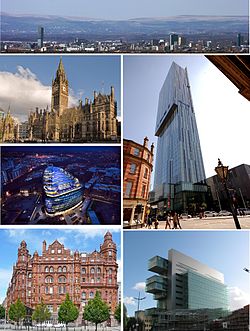 Manchester | |
| Location | |
| Location: | 53°28’1"N, 2°19’59"W |
| Data | |
| Population: | First argument to "number_format" must be a number. |
| Post town: | Manchester |
| Postcode: | M |
| Dialling code: | 0161 |
| Local Government | |
| Council: | Manchester |
Manchester is a major city of southern Lancashire. With its surrounding suburbs and contiguous towns, Manchester has highest population of any urban area in the United Kingdom after London.
Manchester sits in the low ground of southern Lancashire drained by the Mersey basin and the rivers feeding it, with the Pennines to the north and east. The Cheshire plain lies to the south, across the Mersey. The city centre, the town's origin, is built on a sandstone bluff near the meeting of the rivers Medlock and Irwell.
A child of the Industrial Revolution, Manchester grew swiftly as an industrial city in the nineteenth century, absorbing in its growth several villages and towns of southern Lancashire, and continuing to grow in the twentieth century. Nevertheless, the town has an early origin; it first appears in history as the Roman fort of Mamucium, which was established around 79 AD. In the Anglo-Saxon period Manchester was apparently a fortified town; the Mercian army is recorded as having taken Mameceaster on Norþhymbrum from the Norsemen in 919.[1]
Manchester today is a centre of the arts, the media, higher education and commerce, factors all contributing to Manchester claim to be Britain's second city.[2] In a poll of British business leaders published in 2006, Manchester was regarded as the best place in the United Kingdom to locate a business.[3] In 2007, a report commissioned by Manchester Partnership showed Manchester then to be the "fastest-growing city" economically.[4]
Manchester is the third-most visited city in the United Kingdom by foreign visitors, beaten only by London and Edinburgh.[5]
The city has a strong sporting tradition, with two Premier League football teams, Manchester United and Manchester City, and just outside the city the home ground of Lancashire County Cricket Club. Manchester was the host of the 2002 Commonwealth Games.
The name of the city
Manchester was known to the Romans as Mamucium, generally thought to be a Latinisation of an original British Celtic name possibly meaning "breast-like hill" from mamm ("breast"). The Old English name Mameceaster derives from the same root, with ceaster meaning "city" of "fortified town", ultimately from the Latin castra.[6]
An alternative theory suggests that the origin is British mamma meaning "mother", possibly referring to a river-goddess of the River Medlock which flows below the site of the fort. Mam means "female breast" in Irish Gaelic and "mother" in Welsh.[7]
History
Manchester is truly a child of the Lancastrian Industrial Revolution. Throughout the Middle Ages, Manchester remained a manorial township, but it began expanding at an astonishing rate around the opening of the 19th century as part of a process of unplanned urbanisation brought on by a boom in textile manufacture during the Industrial Revolution.[8] The urbanisation of Manchester largely coincided with the Industrial Revolution and the Victorian era, resulting in it becoming the world's first industrialised city.[9] As the result of an early-19th century factory building boom, Manchester was transformed from a township into a major mill town, a borough and was later granted city status, in 1853.
Early history
Iron Age tribes had a stronghold in the locality at a sandstone outcrop on which Manchester Cathedral now stands, opposite the banks of the River Irwell.[10] This would have commanded a territory extending across the fertile lowland of what is now Salford and Stretford. After the Roman conquest of Britain in the 1st century, General Agricola ordered the construction of a fort named Mamucium in the year 79 AD to ensure that Roman interests in Deva Victrix (Chester) and Eboracum (York) were protected in case of rebellion fro among the local Brigantes.[10] A stabilised fragment of foundation from the final rebuilding of the Roman fort is visible in Castlefield. The Roman habitation of Manchester may have ended around the 3rd century, when the vicus, or civilian settlement, appears to have been abandoned.[11]
The location of the Northumbrian and Vikiing fortress of Mameceaster is not known for certain but must be presumed to have stood on the old Roman site. By the time of the Norman Conquest in 1066, the focus of the town had shifted to the meeting of the rivers Irwell and Irk.[12] Much of the wider area was laid waste in the subsequent Harrying of the North.[13][14]
The Middle Ages
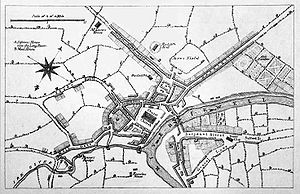

Manchester is mentioned as having a market in 1282.[15] Around the 14th century, the town received an influx of Flemish weavers, sometimes credited as the foundation of the region's textile industry.[16]
Thomas de la Warre, lord of the manor, founded and constructed a collegiate church for the parish in 1421, which church still stands, now as Manchester Cathedral. The domestic premises of de la Warre's college currently house Chetham's School of Music and Chetham's Library.[12][17] The library, which opened in 1653 and is still open to the public today, is the oldest free public reference library in the United Kingdom.[18]
The Modern Period
Manchester became an important centre for the manufacture and trade of woollens and linen, and by about 1540, had expanded to become, in John Leland's words, "The fairest, best builded, quickest, and most populous town of all Lancashire."[12] The cathedral and Chetham's buildings are the only significant survivors of Leland's Manchester.[13]
During the English Civil War, Manchester strongly favoured the Parliamentary interest. Although not long lasting, Cromwell granted it the right to elect its own member to Parliament . The only MP actually to sit for Manchester in this time was Charles Worsley, who sat for only a year, and was later appointed Major General for Lancashire, Cheshire and Staffordshire during the Rule of the Major Generals. He was a diligent puritan, turning out ale houses and banning the celebration of Christmas; he died in 1656.[19]
Significant quantities of cotton began to be used after about 1600, firstly in linen/cotton fustians, but by around 1750 pure cotton fabrics were being produced and cotton had overtaken wool in importance.[12] The Irwell and Mersey were made navigable by 1736, opening a route from Manchester to the sea docks on the Mersey. The Bridgewater Canal, Britain's first wholly artificial waterway, was opened in 1761, bringing coal from mines at Worsley to central Manchester. The canal was extended to the Mersey at Runcorn by 1776. The combination of competition and improved efficiency halved the cost of coal and halved the transport cost of raw cotton.[12][17] Manchester became the dominant marketplace for textiles produced in the surrounding towns.[12] A commodities exchange, opened in 1729,[13] and numerous large warehouses, aided commerce.
The Industrial Revolution

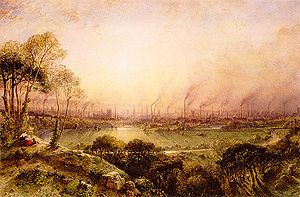
In 1780, Richard Arkwright began construction of Manchester's first cotton mill.[13][17]
Much of Manchester's history is concerned with textile manufacture during the Industrial Revolution. The great majority of cotton spinning took place in the towns of south Lancashire and north Cheshire, and Manchester was for a time the most productive centre of cotton processing,[20] and later the world's largest marketplace for cotton goods.[12][21]
Manchester was dubbed "Cottonopolis" and "Warehouse City" during the Victorian era.[20] In Australia, New Zealand and South Africa, the term "manchester" is still used for household linen: sheets, pillow cases, towels, etc.[22]
Manchester began expanding "at an astonishing rate" around the turn of the 19th century as part of a process of unplanned urbanisation[23] brought on by the Industrial Revolution.[24] It developed a wide range of industries, so that by 1835 "Manchester was without challenge the first and greatest industrial city in the world."[21] Engineering firms initially made machines for the cotton trade, but diversified into general manufacture. Similarly, the chemical industry started by producing bleaches and dyes, but expanded into other areas. Commerce was supported by financial service industries such as banking and insurance. Trade, and feeding the growing population, required a large transport and distribution infrastructure: the canal system was extended, and Manchester became one end of the world's first intercity passenger railway—the Liverpool and Manchester Railway. Competition between the various forms of transport kept costs down.[12] In 1878 the Post Office provided its first telephones to a firm in Manchester.[25]
The Manchester Ship Canal was built in 1894, in some sections by canalisation of the Rivers Irwell and Mersey, running 36 miles from Salford to Eastham Locks on the tidal Mersey, which enabled ocean-going ships to sail right into the Port of Manchester. On the canal's banks, just outside the borough, the world's first industrial estate was created at Trafford Park.[12] Large quantities of machinery, including cotton processing plant, were exported around the world.
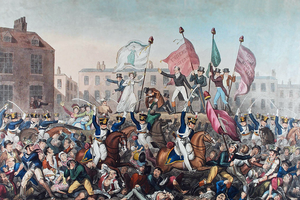
The new industrialism brought with it a huge influx of labour and housing for the workforce, often in poor conditions. Nineteenth century Manchester saw bread riots and labour riots, and calls for greater political recognition by the city's working and non-titled classes. One notorious event in this period of the city's history y took place on 16 August 1819, when the yeomanry broke up a meeting at St Peter's Fields of some 50,000 calling for universal manhood suffrage and repeal of the Corn Laws. The result was known as "the Peterloo Massacre".
The Chartist Movement developed in Manchester, and the town was the centre of the Anti-Corn Law League from 1838.
Industrial Manchester become the subject of the work by Friedrich Engels The Condition of the Working Class in England in 1844 which became a seminal early Marxist text, and when Karl Marx visited Manchester, they met at Chetham's Library. The economics books Marx was reading at the time can be seen on the shelf in the library, as can the window seat where Marx and Engels would meet. The first Trades Union Congress was held in Manchester (at the Mechanics' Institute on David Street) from 2 to 6 June 1868. Manchester was also an important cradle of the Labour Party and of the Suffragette Movement.[26]
In contrast, the Manchester School developed "Manchester Capitalism" during the Victorian period, promoting free trade and laissez-faire).
Manchester became known as a centre for innovation, and not just in industry and politics but in social organisation, education and religion. It attracted educated visitors from all parts of Britain and Europe, leading to the saying that: "What Manchester does today, the rest of the world does tomorrow."[27]
Manchester's golden age was perhaps the last quarter of the 19th century. Many of the great public buildings (including the grand, gothic Town Hall) date from that time. The city's cosmopolitan atmosphere contributed to a vibrant culture, which included the Hallé Orchestra.
Although the Industrial Revolution brought wealth to the city, it also brought poverty and squalor to a large part of the population. Historian Simon Schama has noted that "Manchester was the very best and the very worst taken to terrifying extremes, a new kind of city in the world; the chimneys of industrial suburbs greeting you with columns of smoke". An American visitor taken to Manchester's blackspots saw "wretched, defrauded, oppressed, crushed human nature, lying and bleeding fragments".[28]
The number of cotton mills in Manchester itself reached a peak of 108 in 1853.[20] Thereafter the number began to decline and Manchester was surpassed as the largest centre of cotton spinning by Bolton in the 1850s and Oldham in the 1860s.[20] However, this period of decline coincided with the rise of city as the financial centre of the region.[20] Manchester continued to process cotton, and in 1913, 65% of the world's cotton was processed in the area.[12] The First World War interrupted access to the export markets. Cotton processing in other parts of the world increased, often on machines produced in Manchester. Manchester suffered greatly from the Great Depression of the 1920s and the underlying structural changes that began to supplant the old industries, including textile manufacture.
The Second World War and the Manchester Blitz
Like most of the United Kingdom, the Manchester area mobilised extensively during the Second World War. The locomotive works in Gorton was switched to bomb making; Dunlop's rubber works in Chorlton-on-Medlock made barrage balloons; and just outside the city in Trafford Park, engineers made the Avro Manchester and Avro Lancaster bombers and Ford built the Rolls-Royce Merlin engines to power them. Manchester was thus the target of bombing by the Luftwaffe, and by late 1940 air raids were taking place against non-military targets. The biggest took place during the "Manchester Blitz|Christmas Blitz" on the nights of 22/23 and 23/24 December 1940, when an estimated 467 long ton|tons (475 tonnes) of high explosives plus over 37,000 incendiary bombs were dropped. A large part of the historic city centre was destroyed, including 165 warehouses, 200 business premises, and 150 offices. 376 were killed and 30,000 houses were damaged.[29] Manchester Cathedral was among the buildings seriously damaged; its restoration took 20 years.
After the Second World War
Cotton processing and trading continued to fall in peacetime, and the exchange closed in 1968.[12] By 1963 the port of Manchester was the United Kingdom's third largest,[30] and employed over 3,000 men, but the canal was unable to handle the increasingly large container ships. Traffic declined, and the port closed in 1982.[31] Heavy industry suffered a downturn from the 1960s and was greatly reduced when state subsidies were removed after 1979. Manchester lost 150,000 jobs in manufacturing between 1961 and 1983.[12]
Regeneration began in the late 1980s, with initiatives such as the Metrolink, the Bridgewater Concert Hall, the Manchester Evening News Arena, and (in Salford) the rebranding of the port as Salford Quays. Two bids to host the Olympic Games were part of a process to raise the international profile of the city.[32]
The opening of the twenty-first century
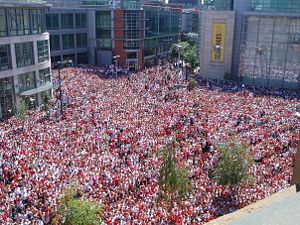
Spurred by the investment after the 1996 IRA bomb, and aided by the XVII Commonwealth Games in 2002, Manchester's city centre has undergone extensive regeneration.[32] New and renovated complexes such as The Printworks and The Triangle have become popular shopping and entertainment destinations. The Manchester Arndale is the United Kingdom's largest city centre indoor shopping centre.[33]
Large sections of the city dating from the 1960s have been either demolished and re-developed or modernised with the use of glass and steel. Old mills have been converted into modern apartments, and million-pound lofthouse apartments have since been developed. The 555-foot tall, 47-storey Beetham Tower, completed in 2006, is the tallest building in the United Kingdom outside London and the highest residential accommodation in western Europe. The lower 23 floors form the Hilton Hotel, featuring a "sky bar" on the 23rd floor. Its upper 24 floors are apartments.[34]
People
Inhabitants of Manchester are known as Mancunians. The city has a local accent which is a distinctive version of the Lancastrian accent.
The United Kingdom Census of 2001 showed a total resident population for the City of Manchester, excluding the suburbs beyond its civic areas, of 392,819, a 9.2% decline from the 1991 census.[35] Approximately 83,000 were aged under 16, while 285,000 were aged 16–74, and 25,000 aged 75 and over.[35] 75.9% of Manchester's population claim they have been born in the United Kingdom, according to the 2001 UK Census.
Manchester reported the second-lowest proportion of the population in employment of any area in the United Kingdom. One reason cited for Manchester's high unemployment figure is the high proportion of the population who are students.[35] A 2007 report noted "60 per cent of Manchester people are living in some of the United Kingdom's most deprived areas".[4]
Historically the population of Manchester only began to increase swiftly during the Victorian era and peaked at 766,311 in 1931. After the peak the population began to decrease rapidly, reasons cited for this are slum clearance and the increased building of social housing overspill estates by Manchester City Council after the Second World War.[36]
According to a Eurostat measure of functional city-regions, the Manchester "Larger Urban Zone" had a population of 2,539,100 in 2004.[37] In addition to Manchester itself, the LUZ includes the several towns surrounding it classed as "Greater Manchester".[38] The Manchester LUZ is the largest within the United Kingdom after that of London.
Estimates in 2005 classed 77.6% people as 'White', 3.2% as 'Mixed race', 10.3% as South Asian, 5.2% as 'Black', 2.3% as Chinese, and 1.4% as another ethnic group.[39] Kidd identifies Moss Side, Longsight, Cheetham Hill, Rusholme, as centres of population for ethnic minorities.[12]
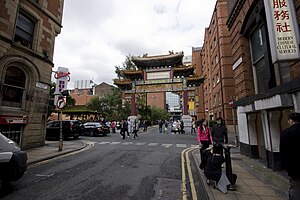
Manchester's Irish Festival, including a St Patrick's Day parade, is one of Europe's largest.[40] There is also a well-established Chinatown in the city with a substantial number of oriental restaurants and Chinese supermarkets. The area also attracts large numbers of Chinese students to the city, attending the local universities.[41]
I the 2001 census, 62.4% of the population are stated as Christian and 9.1% Muslim. Other religions represent less than 1% each. The number of people without a religion is above the national average at 16%, with 9.7% not stating their religion.[42]
Based on the population estimates for 2005, crime levels in the city are considerably higher than the national average. Some parts of Manchester were adversely affected by its rapid urbanisation, resulting in high levels of deprived high-crime areas such as Moss Side and Wythenshawe.[43]
Economy
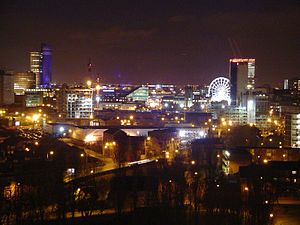
Manchester was at the forefront of the 19th-century Industrial Revolution, and was a leading centre for manufacturing.
The city's economy is now largely service-based and, as of 2007, is the fastest growing in the United Kingdom, with inward investment second only to the capital.[44] Manchester's State of the City Report identifies financial and professional services, life science industries, creative, cultural and media, manufacturing and communications as major activities.[44] The city was ranked in 2007 and 2008 as the second-best place to do business in the United Kingdom,[45] and in 2009 as the third-best city in the United Kingdom and sixteenth best in Europe.[46]
Manchester has the largest office market in Britain outside London.[47] "Greater Manchester" represents over £42 billion of the United Kingdom GVA; more than Wales or North-East England.[48]
Manchester is a focus for businesses which serve local, regional and international markets.[47] It is one of the largest financial centres in Europe with more than 15,000 people employed in banking and finance and more than 60 banking institutions.[47] The Co-operative Group, the world's largest consumer-owned business, is based in Manchester and is one of the city's biggest employers. Legal, accounting, management consultancy and other professional and technical services exist in Manchester.[47]
Manchester's commercial centre is in the centre of the city, next to Piccadilly, its focuses on Mosley Street, Deansgate, King Street and Piccadilly. Spinningfields is a £1.5 billion mixed-use development that is expanding the district west of Deansgate. The area is designed to hold office space, retail and catering facilities, and courts. Several high-profile tenants have moved in, and a new court house, the Civil Justice Centre, opened in October 2007.[49]
Manchester is the commercial, educational and cultural focus for North West England,[47] and is ranked as the third or fourth biggest retail area in the United Kingdom by sales.[50] The city centre retail area contains shops from chain stores up to high-end boutiques such as Vivienne Westwood, Emporio Armani, DKNY, Harvey Nichols, Chanel and Hermès. The city has several shopping malls including the Manchester Arndale, the United Kingdom's largest inner city shopping mall.[33]
Sights around the city
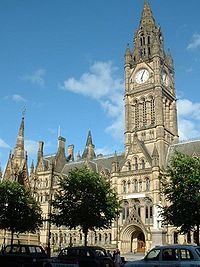
Manchester's buildings display a variety of architectural styles, ranging from Victorian to contemporary architecture. The widespread use of red brick characterises the city. Much of the architecture in the city harks back to its days as a global centre for the cotton trade.[17] Just outside the immediate city centre are many former cotton mills, some left untouched since they closed, others redeveloped into apartment buildings and office space.
Manchester Town Hall, in Albert Square, was built in the Gothic revival style and is considered to be one of the most important Victorian buildings in England.[51] It has been used in film as a replacement location for the Palace of Westminster, in which filming is not permitted.[52]
High buildings
Manchester also has a number of skyscrapers built during the 1960s and 1970s, the tallest of which was the CIS Tower located near Manchester Victoria station until the Beetham Tower was completed in 2006; it is an example of the new surge in high-rise building and includes a Hilton hotel, a restaurant, and apartments. On its completion, it was the tallest building in the United Kingdom outside London, although an even taller building, the Piccadilly Tower, began construction behind Manchester Piccadilly station in early 2008 (a project currently in abeyance).[53] The Green Building, opposite Oxford Road station, is a pioneering eco-friendly housing project, one of very few in the United Kingdom. The award-winning Heaton Park in the north of the city borough is one of the largest municipal parks in Europe, covering 610 acres of parkland.[54] The city has 135 parks, gardens, and open spaces.[55]
Monuments
Two large squares hold many of Manchester's public monuments. Albert Square has monuments to Prince Albert, Bishop James Fraser, Oliver Heywood, William Ewart Gladstone,and John Bright. Piccadilly Gardens has monuments dedicated to Victoria of the United Kingdom|Queen Victoria, Robert Peel, James Watt and the Duke of Wellington. The cenotaph in St Peter's Square, by Edwin Lutyens, is Manchester's main memorial to its war dead. The Alan Turing Memorial in Sackville Park commemorates his role as the father of modern computing.
A larger-than-life statue of Abraham Lincoln by George Gray Barnard in the eponymous Lincoln Square (having stood for many years in Platt Fields) was presented to the city by Mr. and Mrs. Charles Phelps Taft of Cincinnati, Ohio, to mark the part that Lancashire played in the cotton famine and American Civil War of 1861–1865.[56] A Concorde is on display near Manchester Airport.
Culture
Music
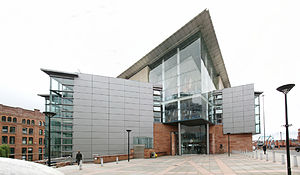
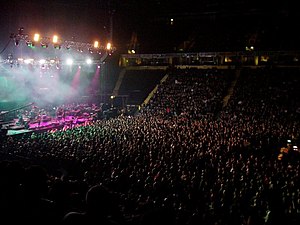
Manchester has two symphony orchestras, the Hallé and the BBC Philharmonic. There is also a chamber orchestra, the Manchester Camerata. In the 1950s, the city was home to the so-called 'Manchester School' of classical composers, which comprised Harrison Birtwistle, Peter Maxwell Davies, David Ellis and Alexander Goehr. Manchester is a centre for musical education, with the Royal Northern College of Music and Chetham's School of Music.[57] The main classical venue was the Free Trade Hall on Peter Street, until the opening in 1996 of the 2,500 seat Bridgewater Hall.[58]
Brass band music, a tradition in Lancashire, is an important part of Manchester's musical heritage;[59] some of the United Kingdom's leading bands, such as the Co-operative Wholesale Society Manchester Band and the Fairey Band, are from Manchester and surrounding areas, and the Whit Friday brass band contest takes place annually in the neighbouring areas of Saddleworth and Tameside.
Popular music bands that have emerged from the Manchester music scene include The Smiths, the Buzzcocks, The Fall, Joy Division and its successor group New Order, Oasis, Doves and Ten. Manchester was credited as the main regional driving force behind Indie music|indie bands of the 1980s including Happy Mondays, Inspiral Carpets, James, and The Stone Roses. These groups came from what became known as the "Madchester" scene that also centred around the Fac 51 Haçienda (also known as simply The Haçienda) developed by founder of Factory Records, Tony Wilson. Although from southern England, The Chemical Brothers subsequently formed in Manchester.[60] Ex-Stone Roses' frontman Ian Brown and ex-Smiths Morrissey continue successful solo careers.
Other notable Manchester acts include Take That, 10CC and Simply Red. Older Manchester artists include the 1960s bands The Hollies, Herman's Hermits and the Bee Gees who, while commonly associated with Australia, grew up in Chorlton.[61]
Manchester's main pop music venue is the Manchester Evening News Arena, situated next to Victoria station. It seats over 21,000, is the largest arena of its type in Europe, and has been voted International Venue of the Year.[62] In terms of concert goers, it is the busiest indoor arena in the world, ahead of Madison Square Garden in New York and the O2 Arena in London, the second and third busiest respectively.[63] Other major venues include the Manchester Apollo and the Manchester Academy. Smaller venues include the Band on the Wall Roadhouse, the Night and Day Cafe, the Ruby Lounge, and The Deaf Institute.
Performing arts
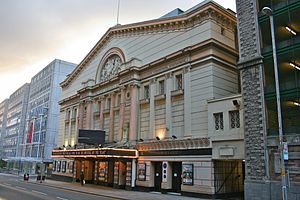
Manchester has a thriving theatre, opera and dance scene, and is home to a number of large performance venues, including the Manchester Opera House, which feature large-scale touring shows and West End productions; the Palace Theatre; the Royal Exchange Theatre in Manchester's former cotton exchange; and the Lowry Centre, a touring venue in Salford which often hosts performances by Opera North.
Smaller performance spaces include the Library Theatre, a producing theatre in the basement of the Central Library; the Green Room; the Contact Theatre; and Studio Salford. The Dancehouse is dedicated to dance productions.[64] The Library Theatre will close in 2010, and reopen in 2011 inside the old Theatre Royale on St Peters Street.
Museums and galleries

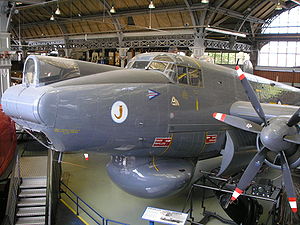
Manchester has a wide selection of public museums and art galleries.[65] Manchester's museums celebrate Manchester's Roman history, rich industrial heritage and its role in the Industrial Revolution, the textile industry, the Trade Union movement, women's suffrage and football.
In Castlefield, a reconstructed part of the Roman fort of Mamucium is open to the public. The Museum of Science and Industry, housed in the former Liverpool Road railway station, has a large collection of steam locomotives, industrial machinery and aircraft.[66] The Museum of Transport in Manchester|Museum of Transport displays a collection of historic buses and trams.[67]
Salford Quays, a short distance from the city centre, is home to the Imperial War Museum North.[68] The Manchester Museum opened to the public in the 1880s, has notable Egyptology and natural history collections.[69]
The municipally-owned Manchester Art Gallery on Mosley Street houses a permanent collection of European painting, and has one of Britain's most significant collections of Pre-Raphaelite paintings.[70][71]
In the south of the city, the Whitworth Art Gallery displays modern art, sculpture and textiles.[72] Other exhibition spaces and museums in Manchester include Cornerhouse, Manchester|the Cornerhouse, the Urbis centre, the Manchester Costume Gallery at Platt Fields Park, the People's History Museum, the Manchester United Museum in Old Trafford football stadium and the Manchester Jewish Museum.[73]
The works of Stretford-born painter L.S. Lowry, known for his "matchstick" paintings of industrial Manchester and Salford, can be seen in both the city and Whitworth Manchester galleries, and at the Lowry art centre in Salford Quays (in the neighbouring borough of Salford) devotes a large permanent exhibition to his works.[74]
Literature
In the 19th century, Manchester featured in works highlighting the changes that industrialisation had brought to Britain. These included Elizabeth Gaskell's novel Mary Barton: A Tale of Manchester Life (1848),[75] and The Condition of the Working Class in England in 1844, written by Friedrich Engels while living and working in Manchester. Charles Dickens is reputed to have set his novel Hard Times in the city, and while it is partly modelled on Preston, it shows the influence of his friend Mrs Gaskell.[76]
Sport
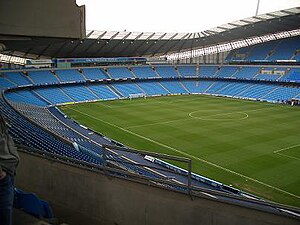
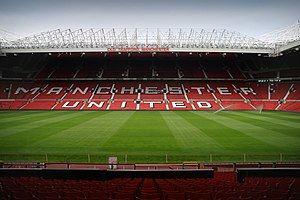
Manchester is well known for being a city of sport. Trafford, just outside the city boundary, is the home ground for Lancashire County Cricket Club. Two Premier League football clubs bear the city's name and vie for Mancunians' loyalty; Manchester United and Manchester City.
Manchester City's ground is at the City of Manchester Stadium (near 48,000 capacity); Manchester United's Old Trafford ground, the largest club football ground in the United Kingdom, with a capacity of 76,000, is just outside the city. Old Trafford is the only club football ground in England to have hosted the UEFA Champions League Final, in 2003. It is also the venue of the Super League Grand Final in rugby league.[77] Premier League champions Manchester United have the widest football club fanbase in the world, while Manchester City is the richest football club in the world, thanks to its wealthy owners.[78]
The City of Manchester Stadium was built for the 2002 Commonwealth Games. After the games, a temporary stand at the northern end of the stadium was dismantled and a permanent structure matching the rest of the stadium was developed. In addition the ground level was lowered by approximately 10m and the entire level 1 seating area was constructed. The capacity for the Games was approximately 38,000. This increased in preparation for Manchester City's arrival in 2003, and the official capacity by April 2008 was recorded as 47,726.[79] The stadium hosted the 2008 UEFA Cup Final.
Manchester City's former home Maine Road, now demolished, still holds a number of significant footballing milestones and records. These include the first World Cup qualifying match staged in England (1949); the record League crowd (83,260, Manchester United V Arsenal, 1948); and the record provincial attendance (84,569, Manchester City V Stoke City, FA Cup, 1934).[80]
First class sporting facilities were built for the 2002 Commonwealth Games, including the City of Manchester Stadium, the National Squash Centre and the Manchester Aquatics Centre.[81] Manchester has competed twice to host the Olympic Games, beaten by Atlanta for 1996 and Sydney for 2000. The Manchester Velodrome was built as a part of the bid for the 2000 games.[82] It hosted the UCI Track Cycling World Championships for the third time in 2008. Various sporting arenas around the city will be used as training facilities by athletes preparing for the 2012 Olympics in London. The Manchester Evening News Arena|MEN Arena hosted the FINA World Swimming Championships in 2008.[83] Manchester also hosted the World Open|World Squash Championships in 2008,[84] and will also host the 2010 World Lacrosse Championship in July 2010.[85]
Outside links
References
- ↑ Anglo-Saxon Chronicle (Parker Chronicle) 919.
- ↑ "Manchester 'England's second city'". BBC. 2002-09-12. http://news.bbc.co.uk/1/hi/england/2253035.stm. Retrieved 2007-05-02.
• "Manchester 'England's Second City'". Ipsos MORI. 2002. http://www.ipsos-mori.com/researchpublications/researcharchive/poll.aspx?oItemId=1038. Retrieved 2009-08-15.
• Riley, Catherine (2005-07-08). "Can Birmingham halt its decline?". London: The Times. http://property.timesonline.co.uk/tol/life_and_style/property/article541043.ece. Retrieved 2007-08-01.
• "Manchester 'close to second city'". BBC. 2005-09-29. http://news.bbc.co.uk/1/hi/england/manchester/4293814.stm. Retrieved 2006-05-02.
• "Manchester tops second city poll". BBC. 2007-02-10. http://news.bbc.co.uk/1/hi/england/6349501.stm. Retrieved 2007-06-18.
• "Birmingham loses out to Manchester in second city face off". BBC. 2007. http://www.bbc.co.uk/pressoffice/pressreleases/stories/2007/02_february/09/birmingham.shtml. Retrieved 2007-06-18. - ↑ "Britain's Best Cities 2005–2006 Executive Summary" (PDF). OMIS Research. 2006. Archived from the original on 2007-11-26. http://web.archive.org/web/20071126231935/http://www.omis.co.uk/Downloads/BBC06.pdf. Retrieved 2007-09-08.
- ↑ 4.0 4.1 "Manchester – The State of the City". Manchester City Council. 2007. http://www.manchester.gov.uk/site/scripts/news_article.php?newsID=2915. Retrieved 2007-09-11.
- ↑ "National Statistics Online – International Visits". ONS. http://www.statistics.gov.uk/cci/nugget.asp?id=178. Retrieved 2009-07-19.
- ↑ Mills, A.D. (2003). A Dictionary of British Place-Names. Oxford: Oxford University Press. ISBN 0-19-852758-6. http://www.oxfordreference.com/pages/Subjects_and_Titles__2B_05.
- ↑ The Antiquaries Journal (ISSN 0003-5815) 2004, vol. 84, pp. 353–357
- ↑ Aspin, Chris (1981). The Cotton Industry. Shire Publications Ltd. p. 3. ISBN 0-85263-545-1.
- ↑ Kidd, Alan (2006). Manchester: A History. Lancaster: Carnegie Publishing. ISBN 1-85936-128-5.
• Frangopulo, Nicholas (1977). Tradition in Action. The historical evolution of the Greater Manchester County. Wakefield: EP Publishing. ISBN 0-7158-1203-3.
• "Manchester United in Celebration of City". European Structural Funding. 2002. http://www.eurofundingnw.org.uk/current_affairs.asp?section=affairs&id=34. Retrieved 2006-12-18. - ↑ 10.0 10.1 Cooper, Glynis (2005). Salford: An Illustrated History. The Breedon Books Publishing Company. p. 19. ISBN 1-85983-455-8.
- ↑ Gregory, Richard (ed) (2007). Roman Manchester: The University of Manchester's Excavations within the Vicus 2001–5. Oxford: Oxbow Books. p. 190. ISBN 978-1-84217-271-1.
- ↑ 12.00 12.01 12.02 12.03 12.04 12.05 12.06 12.07 12.08 12.09 12.10 12.11 12.12 Kidd, Alan (2006). Manchester: A History. Lancaster: Carnegie Publishing. pp. 12, 15–24, 224. ISBN 1-85936-128-5.
- ↑ 13.0 13.1 13.2 13.3 Hylton, Stuart (2003). A History of Manchester. Phillimore & Co. pp. 1–10, 22, 25, 42, 63–67, 69. ISBN 1-86077-240-4.
- ↑ Arrowsmith, Peter (1997). Stockport: a History. Stockport Metropolitan Borough Council. p. 30. ISBN 0-905164-99-7.
- ↑ Letters, Samantha (2005). Gazetteer of Markets and Fairs in England and Wales to 1516. British History Online. p. 19. http://www.british-history.ac.uk/report.aspx?compid=40422&strquery=lancashire. Retrieved 2009-05-05.
- ↑ Pevsner, Nikolaus (1969). Lancashire, The Industrial and Commercial South. London: Penguin Books. p. 265. ISBN 0-14-071036-1.
- ↑ 17.0 17.1 17.2 17.3 Hartwell, Clare (2001). Pevsner Architectural Guides: Manchester. London: Penguin Books. pp. 11–17, 155, 256, 267–268. ISBN 0-14-071131-7.
- ↑ Nicholls, Robert (2004). Curiosities of Greater Manchester. Sutton Publishing. ISBN 0-750-93661-4.
- ↑ Durston, Christopher (2001). Cromwell's major generals: godly government during the English Revolution. Politics, culture, and society in early modern Britain. Manchester: Manchester University Press. ISBN 0-7190-6065-6. http://books.google.com/?id=Hw622QZHTcYC&pg=PA86&lpg=PA86&dq=%22charles+worsley%22. Retrieved 2009-05-05.
- ↑ 20.0 20.1 20.2 20.3 20.4 McNeil, Robina; Michael Nevell (2000). A Guide to the Industrial Archaeology of Greater Manchester. Association for Industrial Archaeology. ISBN 0-9528930-3-7.
- ↑ 21.0 21.1 Hall, Peter (1998). "The first industrial city: Manchester 1760–1830". Cities in Civilization. London: Weidenfeld & Nicolson. ISBN 0-297-84219-6.
- ↑ Manchester, n.. Oxford: Oxford University Press. March 2009. http://dictionary.oed.com/cgi/entry/00300853?query_type=word&queryword=manchester+goods&first=1&max_to_show=10&single=1&sort_type=alpha. Retrieved 2009-05-04.
- ↑ "Timelines.tv Urban Slums". Timelines.tv. http://www.timelines.tv/urban_slums.html.
- ↑ Aspin, Chris (1981). The Cotton Industry. Aylesbury: Shire Publications. p. 3. ISBN 0-85263-545-1.
- ↑ "Events in Telecommunications History". BT Archives. 1878. http://www.btplc.com/Thegroup/BTsHistory/1851to1880/1878.htm. Retrieved 2009-05-05.
- ↑ Kidd, Alan (2006). "Chapter 9 England Arise! The Politics of Labour and Women's Suffrage". Manchester: A history. Lancaster: Carnegie Publishing. ISBN 1-85936-128-5.
- ↑ Speake, Jennifer, ed (2003). The Oxford Dictionary of Proverbs (4th ed.). Oxford University Press. ISBN 0-19-860524-2. http://www.oxfordreference.com/views/ENTRY.html?subview=Main&entry=t90.e1326. Retrieved 2007-07-06. "What Manchester says today, the rest of England says tomorrow"
•George Osborne (March 7, 2007). "Osborne: Our vision to make Manchester the creative capital of Europe". Conservative Party Website. Conservative Party. http://www.conservatives.com/News/Speeches/2007/03/Osborne_Our_vision_to_make_Manchester_the_creative_capital_of_Europe.aspx. Retrieved 2009-05-04. "The saying goes that what Manchester does today the rest of the world does tomorrow."
•"Manchester Life". Manchester Metropolitan University. 2007. Archived from the original on 2007-11-08. http://web.archive.org/web/20071108232358rn_1/www.mmu.ac.uk/studyatmmu/manchesterlife/. Retrieved 2009-05-05. "What Manchester does today, the world does tomorrow" - ↑ "Victoria and Her Sisters". Simon Schama (presenter). A History of Britain. BBC One. 2002-06-04. No. 13.
- ↑ Hardy, Clive (2005). "The blitz". Manchester at War (2nd ed.). Altrincham: First Edition Limited. pp. 75–99. ISBN 1-84547-096-6.
- ↑ Parkinson-Bailey, John J (2000). Manchester: an Architectural History. Manchester: Manchester University Press. p. 127. ISBN 0-7190-5606-3. http://www.manchesteruniversitypress.co.uk/catalogue/book.asp?id=1423.
• Pevsner, Nikolaus (1969). Lancashire, The Industrial and Commercial South. London: Penguin Books. p. 267. ISBN 0-14-071036-1. - ↑ "Salford Quays milestones: the story of Salford Quays" (PDF). Salford City Council. 2005. http://www.salford.gov.uk/milestones_v2.pdf. Retrieved 2009-05-05.
- ↑ 32.0 32.1 Hartwell, Clare (2001). Pevsner Architectural Guides: Manchester. London: Penguin Books. ISBN 0-14-071131-7.
• Parkinson-Bailey, John J (2000). Manchester: an Architectural History. Manchester: Manchester University Press. ISBN 0-7190-5606-3. http://www.manchesteruniversitypress.co.uk/catalogue/book.asp?id=1423.
• Hartwell, Clare; Matthew Hyde, Nikolaus Pevsner (2004). Lancashire: Manchester and the South-East. New Haven & London: Yale University Press. ISBN 0-300-10583-5. http://yalepress.yale.edu/yupbooks/book.asp?isbn=9780300105834. - ↑ 33.0 33.1 "Manchester Arndale". Prudential plc. 2007. http://www.prupim.com/about/properties/showProperty?contentId=3709. Retrieved 2008-10-09.
- ↑ "City building reaches full height". BBC. 26 April 2006. http://news.bbc.co.uk/1/hi/england/manchester/4944590.stm. Retrieved 2008-10-09.
- ↑ 35.0 35.1 35.2 "Manchester profile of 2001 census". Office for National Statistics. 2003. http://www.statistics.gov.uk/census2001/profiles/00BN-A.asp. Retrieved 2006-10-25.
- ↑ Shapely, Peter (2002–3). "The press and the system built developments of inner-city Manchester" (PDF). Manchester Region History Review (Manchester: Manchester Centre for Regional History) 16: 30–39. SSN 0952-4320. http://www.mcrh.mmu.ac.uk/pubs/pdf/mrhr_16_shapely.pdf. Retrieved 2007-11-22.
- ↑ "Urban Audit – City Profiles: Manchester". Urban Audit. http://www.urbanaudit.org/CityProfiles.aspx?CityCode=UK008C&CountryCode=UK. Retrieved 2008-10-05.
- ↑ "Towards a Common Standard" (PDF). Greater London Authority. p. 29. http://www.london.gov.uk/mayor/economic_unit/docs/wp13_towards_a_common_standard.pdf. Retrieved 2008-10-05.
- ↑ "Manchester ethnic grouping percentages". Office of National Statistics. 2005. http://neighbourhood.statistics.gov.uk/dissemination/LeadTableView.do?a=3&b=276778&c=Manchester&d=13&e=13&g=351271&i=1001x1003x1004&m=0&r=1&s=1198673035015&enc=1&dsFamilyId=1812. Retrieved 2007-12-26.
- ↑ "The Manchester Irish Festival: the largest in the United Kingdom". Manchester Irish Festival Website. 2007. http://www.manchesteririshfestival.co.uk. Retrieved 2007-06-28.
- ↑ "History of Manchester's Chinatown". BBC. bbc.co.uk. 2004. http://www.bbc.co.uk/manchester/chinatown/2004/01/history.shtml. Retrieved 2007-11-22.
- ↑ "Religion in Manchester". Manchester City Council. 10 December 2004. http://web.archive.org/web/20041216133618/www.manchester.gov.uk/planning/studies/census/keyfacts/religion.htm. Retrieved 9 July 2010.
- ↑ Nick Ravenscroft (2006-09-11). "Killing surprises few in Moss Side". BBC (bbc.co.uk). http://news.bbc.co.uk/1/hi/england/manchester/5334510.stm. Retrieved 2007-11-22.
- ↑ 44.0 44.1 Manchester Partnership; Manchester City Council; KPMG (September 2007). "Manchester's State of the City Report 2006/2007" (PDF). http://www.manchesterpartnership.org.uk/includes/uploads/File/State%20of%20the%20City%2017%20OCT%20FINAL.pdf. Retrieved 2007-10-21.
- ↑ "London, Manchester and Birmingham lead UK survey of business friendly cities". Cushman & Wakefield web pages. Cushman & Wakefield. 24 September 2008. http://www.cushwake.com/cwglobal/jsp/newsDetail.jsp?repId=c19200007p&LanId=EN&LocId=GLOBAL. Retrieved 2008-09-24.
- ↑ "European Cities Monitor: Warsaw named as favoured city for expansion; London leads again". Cushman & Wakefield. 6 October 2008. http://www.cushwake.com/cwglobal/jsp/newsDetail.jsp?repId=c27300017p&LanId=EN&LocId=GLOBAL. Retrieved 2009-10-07.
- ↑ 47.0 47.1 47.2 47.3 47.4 Anon (2002). "Manchester host city; All about Manchester" (http). m2002.thecgf.com. http://m2002.thecgf.com/Manchester/. Retrieved 2007-11-08.
- ↑ "Regional GVA December 2007 (Page 7)" (PDF). Office for National Statistics. 2007. http://www.statistics.gov.uk/downloads/theme_economy/Regional_GVA_December_2007.pdf. Retrieved 2008-03-29.
- ↑ Calverley, Tom (25 October 2007). "Landmark court opens". Manchester Evening News (M.E.N media). http://www.manchestereveningnews.co.uk/news/s/1021575_landmark_court_opens. Retrieved 2007-11-01.
• Barry, Chris (12 October 2007). "City's 5-star rebirth". Manchester Evening News (M.E.N media). http://www.manchestereveningnews.co.uk/news/s/1019502_citys_5star_rebirth. Retrieved 2007-11-01.
• "Spinningfields". Allied London. 2005. http://www.spinningfields-manchester.com/. Retrieved 2007-11-01. - ↑ "Life in Manchester – Shopping". bbc.co.uk. BBC. 15 December 2004. http://www.bbc.co.uk/manchester/lifeinmanchester/shopping.shtml. Retrieved 2007-10-12.
•Fearis, Beverley (29 September 2007). "Shopping: Spend, spend, spend". Guardian Magazine Supplement (The Guardian). "When it comes to shopping for fashion, Manchester is hard to beat. Rub shoulders with the Wags in the designer stores of Exchange Square and New Cathedral Street ..."
•"Credit crunch resistant retail centres unveiled". CACI web pages. CACI Limited. April 2008. http://www.caci.co.uk/188.aspx. Retrieved 2009-05-04.
•Experian (28 September 2007). "Experian publishes the definitive 2007 retail ranking". Press release. http://press.experian.com/documents/showdoc.cfm?doc=2822. Retrieved 2007-10-12. - ↑ Robinson (1986), The Architecture of Northern England, p. 153
- ↑ "Film Location Charter" (PDF). Manchester City Council. 8 September 2003. http://web.archive.org/web/20061210094514/www.manchester.gov.uk/townhall/documents/filmcharter.pdf. Retrieved 2007-11-12.
•"Filming at Manchester Town Hall". Manchester City Council web pages. Manchester City Council. 17 October 2006. Archived from the original on 2007-04-24. http://web.archive.org/web/20070424185615/http://www.manchester.gov.uk/townhall/venues/filming.htm. Retrieved 2007-11-12. - ↑ "Inacity step out as Ballymore stride in with plans for Eastgate Tower". Manchester Confidential. 2007. http://www.manchesterconfidential.co.uk/property/index.asp?Sessionx=IpqiNw86JwfkNwB6IaqiNwA&realname=Too_hot_to_handle&frombounce=yes. Retrieved 2007-09-11.
- ↑ "About Heaton Park". Manchester City Council. 2005. Archived from the original on March 15, 2008. http://web.archive.org/web/20080315081308/http://www.manchester.gov.uk/site/scripts/documents_info.php?categoryID=200073heaton/&documentID=1422. Retrieved 2007-11-23.
- ↑ "Manchester's parks and open spaces". Manchester City Council. 2005. http://www.manchester.gov.uk/site/scripts/documents.php?categoryID=200073. Retrieved 2007-11-23.
- ↑ Cocks, Harry; Wyke, Terry (2004). Public Sculpture of Greater Manchester. Public Sculpture of Britain. Liverpool: Liverpool University Press. pp. 11–27, 88–92, 111–121, 123–5, 130–2. ISBN 0-85323-567-8.
- ↑ Redhead, Brian (1993). Manchester: a Celebration. London: Andre Deutsch. pp. 60–61. ISBN 0-233-98816-5.
- ↑ "Good Venue Guide; 28 – Bridgewater Hall, Manchester.". Independent on Sunday. 12 April 1998.
- ↑ "Procession – Jeremy Deller". Manchester International Festival. July 2009. http://www.mif.co.uk/events/procession-2/. Retrieved 2009-07-24.
- ↑ "The Chemical Brothers – Alumni". University of Manchester. 2005. http://www.manchester.ac.uk/undergraduate/ourreputation/distinguishedalumni/thechemicalbrothers/. Retrieved 2007-11-12.
- ↑ "Bee Gees go back to their roots". BBC (BBC Online). 12 May 2004. http://news.bbc.co.uk/1/hi/england/manchester/3705559.stm. Retrieved 2007-11-12.
- ↑ "Pollstar Concert Industry Awards Winners Archives". Pollstar Online. 2001. http://www.pollstaronline.com/PCIA-Static/2001winners.htm. Retrieved 2007-06-24.
•Brown, Rachel (10 August 2007). "M.E.N Arena's world's top venue". Manchester Evening News (M.E.N Media). Archived from the original on 2007-09-27. http://web.archive.org/web/20070927192629/http://www.manchestereveningnews.co.uk/entertainment/s/1013/1013264_arenas_worlds_top_venue.html. Retrieved 2007-08-12. "The M.E.N. Arena is the top-selling venue in the world." - ↑ "M.E.N Named Most Popular Entertainment Venue on Planet". http://www.men-arena.com/about/?page_id=1412/. Retrieved 2008-05-08.
- ↑ "The Dancehouse Theatre". thedancehouse.co.uk. http://www.thedancehouse.co.uk/about_us/the_dancehouse_theatre.asp. Retrieved 2009-02-07.
- ↑ "Manchester". Culture24. 2009. http://www.culture24.org.uk/places+to+go/north+west/manchester. Retrieved 2009-07-24.
- ↑ "Explore MOSI". Museum of Science and Industry. 2009. http://www.mosi.org.uk/explore-mosi. Retrieved 2009-07-24.
- ↑ "Vehicle Collection". Greater Manchester Museum of Transport. 2007. http://www.gmts.co.uk/collections/vehicles.html. Retrieved 2009-07-24.
- ↑ "Imperial War Museum North website". Imperial War Museum. http://north.iwm.org.uk/. Retrieved 2009-07-24.
- ↑ "The History of The Manchester Museum". University of Manchester. http://www.museum.manchester.ac.uk/aboutus/history/. Retrieved 2009-07-24.
- ↑ Moss, Richard (2003-10-17). "The Pre-Raphaelite Collections". 24-Hour Museum. http://www.24hourmuseum.org.uk/manchester/local/TRA18176.html?ixsid=0fgOeKoWN6b. Retrieved 2009-07-24.
- ↑ Morris, Edward (2001). Public art collections in north-west England. Liverpool University Press. pp. 118. ISBN 0853235279.
- ↑ "Collection". Whitworth Gallery. http://www.whitworth.manchester.ac.uk/collection/. Retrieved 2009-07-24.
- ↑ "Manchester Museums Guide". Virtual Manchester. 2009. http://www.manchestereventsguide.co.uk/section/museums.html. Retrieved 2009-07-24.
- ↑ "The Lowry Collection". The Lowry. 2009. Archived from the original on November 3, 2005. http://web.archive.org/web/20051103211433/http://www.thelowry.com/lslowry/lslowrycollection.html. Retrieved 2009-07-24.
- ↑ "Elizabeth Gaskell (1810–1865)". BBC. http://www.bbc.co.uk/history/historic_figures/gaskell_elizabeth.shtml. Retrieved 2007-11-02.
- ↑ "Charles Dickens's Hard Times for These Times as an Industrial Novel". Archived from the original on 2006-09-27. http://web.archive.org/web/20060927101031/http://www.victorianweb.org/authors/dickens/pva/pva27.html. Retrieved 2007-11-02.
- ↑ "Football fever". Visit Manchester web pages. Visit Manchester. http://www.visitmanchester.com/Parts2.aspx?PartId=51&ExperienceId=11. Retrieved 2008-10-06.
• "Sporting heritage". Visit Manchester web pages. Visit Manchester. http://www.visitmanchester.com/Parts2.aspx?ExperienceId=11&PartId=120. Retrieved 2008-10-06. - ↑ Qureshi, Yakub (2 September 2008). "The new football powerhouse". Manchester Evening News (M.E.N. media). http://www.manchestereveningnews.co.uk/sport/football/manchester_city/s/1065021_the_new_football_powerhouse. Retrieved 2008-10-06.
- ↑ James, Gary (2008). Manchester – A Football History. Halifax: James Ward. ISBN 978-0-9558127-0-5., pp388-391& p425
- ↑ James, Gary (2008). Manchester – A Football History. Halifax: James Ward. ISBN 978-0-9558127-0-5., pp381-385
- ↑ "Sporting Legacy". Commonwealth Games Legacy Manchester 2002. Commonwealth Games Legacy. 2003. http://web.archive.org/web/20071111071627/http://www.gameslegacy.com/cgi-bin/index.cgi/34. Retrieved 2008-10-06.
- ↑ Parkinson-Bailey, John J (2000). Manchester: an Architectural History. Manchester: Manchester University Press. pp. 249–250, 284–6. ISBN 0-7190-5606-3.
- ↑ "9th Fina World Swimming Championships (25m)". Fina.org. 2008. http://www.fina.org/project/index.php?option=com_content&task=view&id=58&Itemid=380. Retrieved 2008-10-06.
- ↑ "Hi-Tec World Squash Championships – Manchester 2008". Hi-Tec World Squash Championships Manchester 2008. 2008. http://www.worldsquash2008.com/. Retrieved 2009-05-05.
- ↑ "World Lacrosse Championships – Manchester 2010". World Lacrosse Championships 2010. 2010. http://www.2010worldlacrosse.com/. Retrieved 2010-03-29.
Further reading
|
|
| Cities in the United Kingdom |
|---|
|
Aberdeen • Armagh • Bangor (Caernarfonshire) • Bangor (County Down) • Bath • Belfast • Birmingham • Bradford • Brighton and Hove • Bristol • Cambridge • Canterbury • Cardiff • Carlisle • Chelmsford • Chester • Chichester • Colchester • Coventry • Derby • Doncaster • Dundee • Dunfermline • Durham • Ely • Edinburgh • Exeter • Glasgow • Gloucester • Hereford • Inverness • Kingston upon Hull • Lancaster • Leeds • Leicester • Lichfield • Lincoln • Lisburn • Liverpool • City of London • Londonderry • Manchester • Milton Keynes • Newcastle upon Tyne • Newport • Newry • Norwich • Nottingham • Oxford • Perth • Peterborough • Plymouth • Portsmouth • Preston • Ripon • Rochester • Salford • Salisbury • Sheffield • Southampton • St Albans • St Asaph • St David's • Southend-on-Sea • Stirling • Stoke-on-Trent • Sunderland • Swansea • Truro • Wakefield • Wells • Westminster • Winchester • Wolverhampton • Worcester • Wrexham • York |